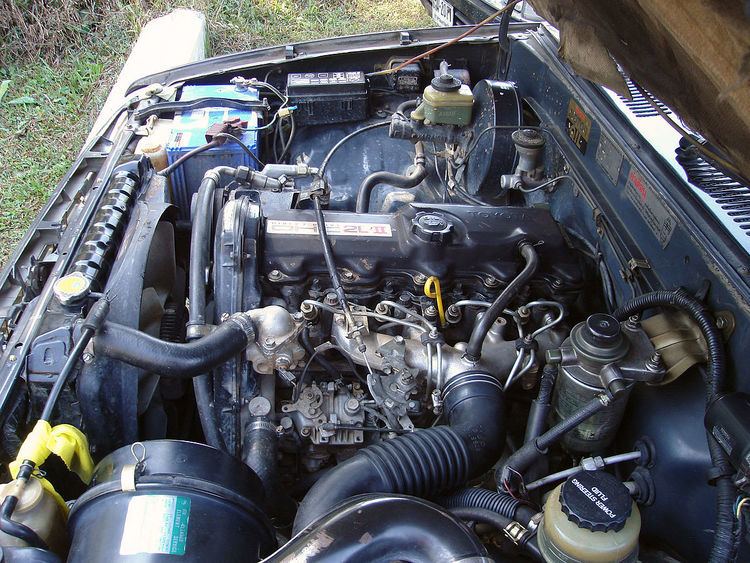 | ||
The L family first appeared in October 1977, it is a series of 4-cylinder diesel engines. It is the first diesel engine from Toyota to use a rubber timing belt in conjunction with a SOHC head. Engines like 2L-II and 2L-T are still in production to the present day. Vehicles with the diesel engine were exclusive to Toyota Japan dealership locations called Toyota Diesel Store locations until the sales channel was disbanded in 1988.
Contents
L
The L is the first L engine produced. Note: Toyota just call it the L engine, not the 1L engine. 2.2 L (2,188 cc), 4-cylinder diesel engine. Output is 72 hp (54 kW) at 4,200 rpm and 93 ft·lb (126 N·m) or 142 N·m JIS. Applications:
2L
The 2L is a 2.4 L (2,446 cc) 4-cylinder diesel engine. Bore is 92 mm and stroke is 92 mm, with a compression ratios of around 22.3:1 and redline of 4800 rpm. Outputs range from 76 to 87 hp (57 to 65 kW) and torque of 15.8–16.8 kg·m (155–165 N·m).
Applications:
2L-II
The 2L-II is an upgrade of the 2L. Bore and stroke remains the same. The most significant change is that the camshaft lifts the valve directly via tappet instead of a rocker arm. The valve clearance is adjusted using shims. Later L engines (3L and 5L) also use this method of valve operation. Maximum output is 89 hp (66 kW) gross at 4,200 rpm and maximum torque is 149 N·m net or 167 N·m (123 lbf·ft) gross at 2,400 rpm.
Applications:
2L-T
The 2L-T is a 2.4 L (2446 cc) turbo version of the 2L still being produced since 1985. The bore and stroke are the same but the 2L-T has a compression ratio of 20:1. Output is 85 to 91 hp (63 to 68 kW) gross at 4,000 rpm with 139 ft·lb (188 N·m) gross of torque at 2,200 rpm.
Applications:
2L-T II
The 2L-T II is an upgrade of the 2L-T. Of the same dimensions as all other 2L engines, the most significant change is that the camshaft lifts the valve directly via tappet instead of a rocker arm. The valve clearance is adjusted using shims. Compression rate is also 20:1. Output is 94 PS (69 kW) at 4000 rpm, 22.0 kg·m (216 N·m) at 2400 rpm
Applications:
2L-TE
Developed as a new version of 2L-T, the 2L-TE features a new development used in Diesel engines at that time, the EFI (Electronic Fuel Injection) system. Although Toyota used this fuel injection system in gasoline engines years before, this is among the first Diesel engines to adopt such a system. Although the basic construction is similar to a modern gasoline injector, the EFI system in 2L-TE utilize considerably higher injection pressures. The EFI system meter fuel with great precision and succeeded in increasing the engine's efficiency. Like the 2L-T, it is 2.4L (2,446 cc) and it is a SOHC (Single Overhead Cam) engine, having 8 valves. It also comes with a Turbo charger. The bore is 92 mm and stroke is also 92 mm. Due to the EFI system, the 2L-TE develops significantly more torque than its predecessor. Maximum horsepower is 97 hp (72 kW) at 3,800 rpm and maximum torque is 22.54 kg·m (221 N·m; 163 lbf·ft) at 2,400 rpm. Redline of this engine is at 4,800 rpm. Compression ratio is 21.0 : 1, slightly higher than 2L-T. 2L-TE was largely replaced by the KZ engine in 1993, although it continued to be used in some models until 2000.
Applications:
2L-THE
High Pressure Charged version of 2L-TE, the fuel is injected with a high pressure system, High Pressure Charging. Bore and stroke remains the same, 92 mm for both. Maximum output was 94–105 PS (69–77 kW) at 4000 rpm and maximum torque was 20.5–22.5 kg·m (201–221 N·m; 148–163 lbf·ft). Compression ratio remains the same, 21.0 : 1. Comes with a Turbo charger and used the EFI (Electronic Fuel Injection) system as well.
Applications:
3L
The 3L is a 2.8 L (2779 cc) four-cylinder diesel engine. Bore is 96 mm and stroke is 96 mm, with a compression ratio of 22.2 : 1. Output is 91 hp (68 kW) gross at 4000 rpm with 19.2 kg·m (188 N·m) gross of torque at 2400 rpm.
5L
The 5L is a 3.0 L (2986 cc) four-cylinder diesel engine. Bore is 99.5 mm and stroke is 96 mm, with a compression ratio of 22.2:1. Output is 97 hp (72 kW) gross at 4000 rpm with 192 N·m (142 lbf·ft) gross of torque at 2400 rpm.
5L-E
The 5L-E is a 3.0 L (2986 cc) EFI version of the 5L engine. It is the latest member of the L family. It has a bore of 99.5 mm and stroke of 96.0 mm, with a compression ratio of 22.2:1. Output (as fitted to the Hilux) is 78 kW (106 PS; 105 hp) gross at 4200 rpm with 197 N·m (145 ft·lb) gross of torque at 2200 rpm. Power output varies according to fitment. The engine number is found on the top face of the block at the front of the engine.
Applications:
